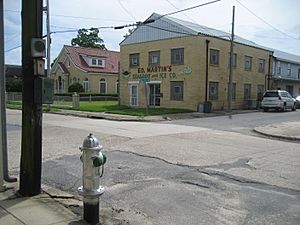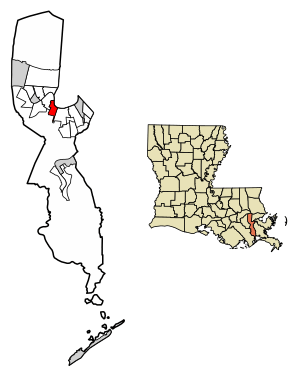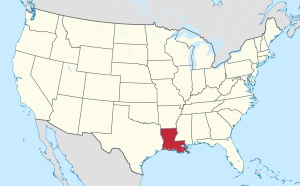Westwego, Louisiana facts for kids
Quick facts for kids
Westwego, Louisiana
|
|||
|---|---|---|---|
| City of Westwego | |||

Ed Martin's
|
|||
|
|||

Location of Westwego in Jefferson Parish, Louisiana
|
|||

Location of Louisiana in the United States
|
|||
| Country | United States | ||
| State | Louisiana | ||
| Parish | Jefferson | ||
| Area | |||
| • Total | 3.60 sq mi (9.31 km2) | ||
| • Land | 3.12 sq mi (8.07 km2) | ||
| • Water | 0.48 sq mi (1.24 km2) | ||
| Elevation | 03 ft (0.9 m) | ||
| Population
(2020)
|
|||
| • Total | 8,568 | ||
| • Rank | JE: 4th | ||
| • Density | 2,749.68/sq mi (1,061.65/km2) | ||
| Time zone | UTC-6 (CST) | ||
| • Summer (DST) | UTC-5 (CDT) | ||
| ZIP code |
70094
|
||
| Area code(s) | 504 | ||
| FIPS code | 22-81165 | ||
| GNIS feature ID | 2405721 | ||
Westwego is a city in the state of Louisiana, in the United States. It is part of Jefferson Parish. Westwego is a community near New Orleans, located on the west bank of the Mississippi River. In 2020, about 8,568 people lived in Westwego.
Contents
What's in a Name? The Story of Westwego
The name Westwego has a few interesting stories behind it. One idea is that it was a popular place to cross the Mississippi River. Many travelers heading west would say, "west we go."
Another story says the name came from a railroad meeting in New York in 1871. People were planning to use the area as a starting point for westward travel. They decided it would be the place where they would say, "...west we go from there." Some people think the name might also be linked to Oswego, New York.
Westwego's Past: A Look at History
Early Days and Growth
Long before Europeans arrived, Native American people lived in the Westwego area. They left behind large mounds of shells, called shell middens. These mounds can still be seen today.
In 1719, French settlers began to develop the area. A French official named Claude le Blanc started a large farm and a port along the Mississippi River. This port became important for trade. Later, the Zeringue family owned the land. They turned it into a busy sugar plantation called Seven Oaks.
Camille Zeringue built a canal on the plantation. This canal was very important to the community for many years. Other big farms in the area included Whitehouse Plantation and Magnolia Lane. After Camille Zeringue died, Pablo Sala bought Seven Oaks. He divided the land into smaller pieces and sold them.
Many people bought these lots after a big hurricane in 1893 destroyed their homes. These families were mostly fishermen and trappers. This is how the community of Salaville started. As Salaville grew, railroad leaders gave it the name "Westwego."
Many businesses grew around the city's wetlands and bayous. These included fishing, shrimping, and seafood canning. Westwego officially became a city in 1951. Its population continued to grow. In recent years, Westwego has worked on restoring historical buildings. This was inspired by historian Daniel P. Alario Sr.
The Grain Elevator Event of 1977
On December 23, 1977, an event happened at the Continental Grain Elevator in Westwego. The grain elevator experienced an explosion. This caused the building to collapse.
The explosion led to the deaths of 36 people and injured at least 11 others. Many people were at a Christmas party in an office building when a concrete tower fell on it. The explosion is thought to have been caused by grain dust catching fire. This type of event is called a dust explosion.
The blast caused large silos to fall over, one after another. This event is known as the deadliest grain elevator accident in history. Because of this and other similar events, new rules were made to help prevent dust explosions.
Where is Westwego? Understanding its Geography
Westwego is located in the larger New Orleans area. The city covers about 3.6 square miles (9.3 square kilometers). Most of this area, about 3.1 square miles (8.1 square kilometers), is land. The rest, about 0.5 square miles (1.2 square kilometers), is water.
Who Lives in Westwego? A Look at its People
| Historical population | |||
|---|---|---|---|
| Census | Pop. | %± | |
| 1930 | 3,987 | — | |
| 1940 | 4,997 | 25.3% | |
| 1950 | 8,328 | 66.7% | |
| 1960 | 9,815 | 17.9% | |
| 1970 | 11,402 | 16.2% | |
| 1980 | 12,663 | 11.1% | |
| 1990 | 11,218 | −11.4% | |
| 2000 | 10,763 | −4.1% | |
| 2010 | 8,534 | −20.7% | |
| 2020 | 8,568 | 0.4% | |
| U.S. Decennial Census | |||
| Race | Number | Percentage |
|---|---|---|
| White (non-Hispanic) | 4,956 | 57.84% |
| Black or African American (non-Hispanic) | 2,326 | 27.15% |
| Native American | 76 | 0.89% |
| Asian | 87 | 1.02% |
| Pacific Islander | 3 | 0.04% |
| Other/Mixed | 360 | 4.2% |
| Hispanic or Latino | 760 | 8.87% |
In 2010, there were 8,534 people living in Westwego. By 2020, the population was 8,568 people.
In 2010, about 32.7% of households had children under 18. About 41.1% were married couples. In 2020, the average age of people in Westwego was 38.9 years. This shows that the population is getting older.
In 2010, most people in Westwego were White (78.16%). About 14.02% were Black or African American. About 4.59% of the population was Hispanic or Latino. By 2020, the city's population became more diverse.
In 2010, the average income for a household was $27,218. For families, it was $31,187. In 2019, the average household income was $30,126. About 28.3% of the people lived below the poverty line.
Learning in Westwego: Schools and Libraries
The Jefferson Parish Public School System runs the public schools in Westwego.
Elementary and Middle Schools
Several elementary schools serve Westwego. These include Isaac G. Joseph Elementary School in Westwego. Gilbert PreK-8 school in Avondale and Truman PreK-8 in Estelle also serve parts of the city. In 2020, two schools, Myrtle C. Thibodeaux and Vic A. Pitre Elementary, joined together. They became Joseph Elementary, named after the first African-American school superintendent.
Most middle school students in Westwego go to Worley Middle School. Some students attend Gilbert PreK-8 and Truman PreK-8.
High Schools and Private Schools
High school students from Westwego attend Higgins High School. This school is in an area that is not officially part of a city.
Our Lady of Prompt Succor Catholic School is a private Catholic school in Westwego. It is part of the Roman Catholic Archdiocese of New Orleans.
Libraries
The Jefferson Parish Library operates the Edith S. Lawson Library in Westwego.
Famous Faces from Westwego
- John Alario: He is a long-serving member of the Louisiana State Legislature. He has been the State Senate President since 2012.
- Sherman A. Bernard: He was the Louisiana insurance commissioner. He lived in Westwego when he was elected in 1972.
- Robert Billiot: He is a member of the Louisiana House of Representatives for Jefferson Parish. He used to be a teacher in Westwego.
- Skyler Green: He grew up in Westwego. He is a professional football player.
See also
 In Spanish: Westwego para niños
In Spanish: Westwego para niños


